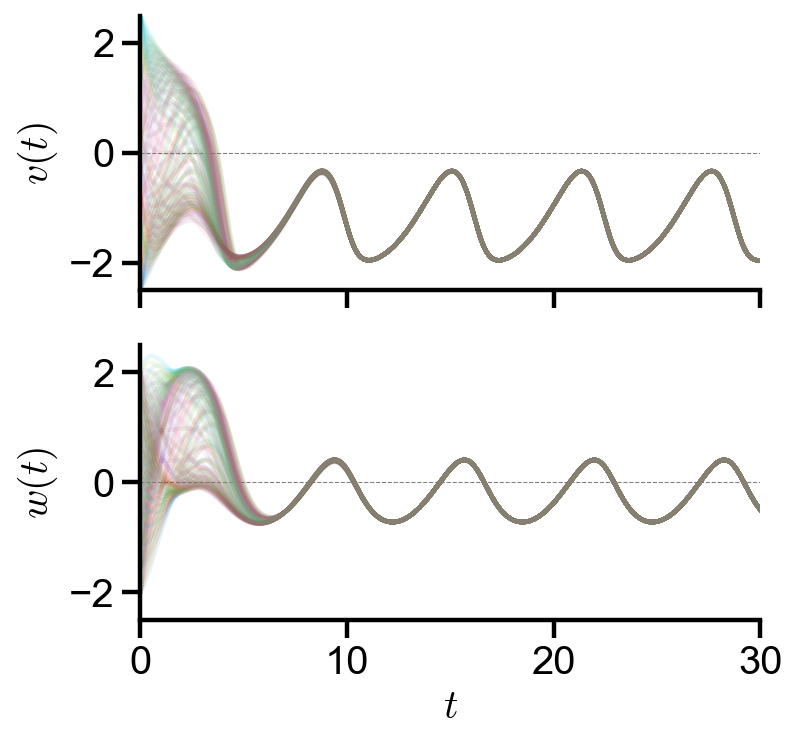Neuron Excitation Model 3#
Teng-Jui Lin
Content adapted from UW AMATH 301, Beginning Scientific Computing. Although not covered in Spring 2020, the topic is presented in previous years.
Phase portraits
FitzHugh-Nagumo neuron excitation model (continued)
Exploration: oscillating external current
FitzHugh-Nagumo neuron excitation model (review)#
Let
with an external electrical current
Note on animation: for local reproducible results, download ffmpeg and add to path variable. For reproducible results online, use Google Colab and run the command below.
# Run the command in Google Colab for reproducible results online
# !apt install ffmpeg
import numpy as np
import matplotlib.pyplot as plt
import scipy
from scipy import integrate
def custom_plot_settings():
%config InlineBackend.figure_format = 'retina'
%matplotlib inline
plt.rcParams.update({
'font.family': 'Arial', # Times New Roman, Calibri
'font.weight': 'normal',
'mathtext.fontset': 'cm',
'font.size': 18,
'lines.linewidth': 2,
'axes.linewidth': 2,
'axes.spines.top': False,
'axes.spines.right': False,
'axes.titleweight': 'bold',
'axes.titlesize': 18,
'axes.labelweight': 'bold',
'xtick.major.size': 8,
'xtick.major.width': 2,
'ytick.major.size': 8,
'ytick.major.width': 2,
'figure.dpi': 80,
'savefig.dpi': 300,
'legend.framealpha': 1,
'legend.edgecolor': 'black',
'legend.fancybox': False,
'legend.fontsize': 14,
'animation.html': 'html5',
})
custom_plot_settings()
Exploration: oscillating external current#
Problem Statement. With the initial conditions of
Generate plots of
Generate an animated phase portrait over time in the intervals
# model params
a = 1
b = 1
tau = 1
# time array
t_initial = 0
t_final = 30
t = np.linspace(t_initial, t_final, 1000)
t_len = len(t)
# ode system
I = lambda t : np.sin(t)
dvdt = lambda t, v, w : v - 1/3*v**3 - w + I(t)
dwdt = lambda t, v, w : (a + v - b*w) / tau
ode_syst = lambda t, z : np.array([dvdt(t, *z), dwdt(t, *z)])
# grid of initial conditions
initial_vvec = np.linspace(-2.5, 2.5, 10)
initial_wvec = np.linspace(-2, 2, 10)
initial_vals = np.meshgrid(initial_vvec, initial_wvec)
initial_vals = np.array([initial_vals[0].reshape(-1), initial_vals[1].reshape(-1)]).T
# ode soln for grid of initial conditions
ode_solns = [0]*len(initial_vals)
for i in range(len(initial_vals)):
ode_solns[i] = scipy.integrate.solve_ivp(ode_syst, [t_initial, t_final], initial_vals[i], t_eval=t).y
ode_solns = np.array(ode_solns)
# quiver grid
vvec = np.linspace(-2.5, 2.5, 20)
wvec = np.linspace(-2, 2, 20)
V, W = np.meshgrid(vvec, wvec)
custom_plot_settings()
fig, axs = plt.subplots(2, 1, figsize=(5, 5), sharex=True)
axs[0].set_ylabel('$v(t)$')
axs[1].set_ylabel('$w(t)$')
axs[1].set_xlabel('$t$')
for i in range(len(initial_vals)):
axs[0].plot(t, ode_solns[i, 0], label='$v(t)$', alpha=0.1)
axs[1].plot(t, ode_solns[i, 1], label='$w(t)$', alpha=0.1)
for i in range(2):
axs[i].plot([t_initial, t_final], [0, 0], '--', color='grey', lw=0.5, zorder=0) # zero ref
axs[i].set_xlim(t_initial, t_final)
axs[i].set_ylim(-2.5, 2.5)

def make_animation(t_range=t_len, anim_time=4, fps=60, xmin=-2.5, xmax=2.5, ymin=-2, ymax=2):
'''
This function is notebook-specific and not meant to generalize to other settings.
Makes animation of time-dependent phase portrait.
Warning: Many parameters are taken from the global namespace. They need to be defined before use.
'''
# back to static plot and animations
custom_plot_settings()
# plot static portion
fig, ax = plt.subplots(figsize=(5, 5))
ax.set_xlim(xmin, xmax)
ax.set_ylim(ymin, ymax)
ax.set_xlabel('$v(t)$')
ax.set_ylabel('$w(t)$')
plt.tight_layout()
# plot empty framework
points = np.zeros(len(initial_vals), dtype=object)
current_points = np.zeros(len(initial_vals), dtype=object)
for i in range(len(initial_vals)):
points[i], = ax.plot([], [], '.', color='black', alpha=0.05)
current_points[i], = ax.plot([], [], '.', color='red', alpha=0.2, zorder=10)
scale = np.sqrt(dvdt(t[0], V, W)**2 + dwdt(t[0], V, W)**2)
qr = ax.quiver(V, W, dvdt(t[0], V, W)/scale, dwdt(t[0], V, W)/scale,
scale, cmap='winter_r', scale=20, width=0.005, zorder=3)
title = ax.set_title('')
def draw_frame(n):
'''
Commands to update parameters.
Here, the phase portrait data points and quiver each frame.
'''
time_points = round(t_range/frame_num)
frame_final_time = min(time_points*n+time_points, t_range-1) # avoid index out of range
for i in range(len(initial_vals)):
points[i].set_data(ode_solns[i, :, :frame_final_time])
current_points[i].set_data(*ode_solns[i, :, frame_final_time-1:frame_final_time])
scale = np.sqrt(dvdt(t[frame_final_time], V, W)**2 + dwdt(t[frame_final_time], V, W)**2)
qr.set_UVC(dvdt(t[frame_final_time], V, W)/scale, dwdt(t[frame_final_time], V, W)/scale, C=scale)
title.set_text(f't = {t[frame_final_time] :.3f}')
return fig,
# create animation of given time length
# note here we fit all the data points into the given animation time
from matplotlib import animation
frame_num = int(fps * anim_time)
anim = animation.FuncAnimation(fig, draw_frame, frames=frame_num, interval=1000/fps, blit=True)
plt.close() # disable showing initial frame
return anim
# convert animation to video (time-limiting step)
from IPython.display import HTML
anim = make_animation() # uses custom function above
HTML(anim.to_html5_video() + '<style>video{width: 400px !important; height: auto;}</style>')
# convert animation to video (time-limiting step)
from IPython.display import HTML
anim = make_animation(t_range=int(t_len/3)) # uses custom function above
HTML(anim.to_html5_video() + '<style>video{width: 400px !important; height: auto;}</style>')

